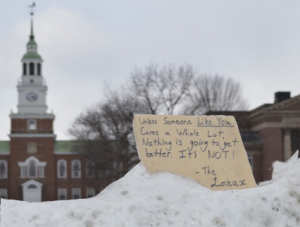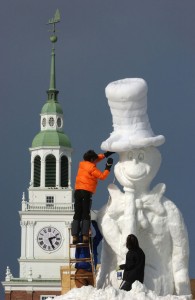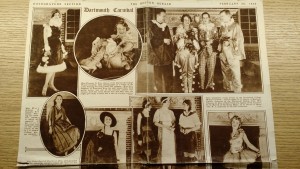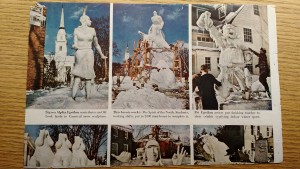
A group of students left the above message on the Green as a comment on this year’s sculpture situation.
For the first time in three score and ten years, the Green remained uncrowned by the annual Winter Carnival snow sculpture until the very last minute. As of late, this omission has become increasingly evident, starting with Dartblog writer Joe Asch’s observation on the first of February that the Green remained devoid of any snow, let alone any sculpture. While Hanover has reclaimed her long-lost coat of snow, our Blitz inboxes only just received the first calls to mobilize and build the snow sculpture. New of the initial cancellation word came from The Dartmouth citing Collis Director Anna Hall, who attributes the decision to forego construction on unseasonably warm weather and student apathy. The same article quotes snow sculpture chair and architect emeritus Benjamin Meigs ’10 saying, “College has gotten more about pre-professional prep — more about building the resume and less about finding unique experiences. Building something out of snow in middle of campus won’t stick well on your resume.”
How, then, did this happen? Adam Smith wrote, “There is a great deal of ruin in a nation,” after hearing of the British defeat at Saratoga. Comparing the dizzying heights of Winter Carnival’s gathering of winter sportsmen and bright women to today’s sordid booze-soaked affair, it is clear that there was a great deal of ruin in Carnival. Following the trajectory of other elements of the Dartmouth Gemeinschaft, like Tubestock, our residential houses, our Greek system, and our undergraduate education reputation, Winter Carnival has deflated on itself, with our studentry gazing inward.
As they say, those who don’t learn their history are doomed to hear that George Santayana quotation over and over again. Let us dive into the saga of the Carnival and its lost traditions: the frenzy of skiers both male and female; the Queen of the Snows pageant, discontinued with the co-educational revolution of 1972; and now, perhaps, the snow sculpture.
Do You Want to Build a Snowman: Our Story Begins (1910 to the 1930s)
“The question, ‘What is there to do at Dartmouth in the winter?’ gives rise to the thought that we might take better advantage of the splendid opportunities which the admirable situation of our College offers.” — F.H. Harris
The origins of Winter Carnival lie in a letter sent by Dartmouth Outing Club (DOC) President F. H. Harris ’11 to the Daily Dartmouth advocating the establishment of a “ski and snow shoe club” to “stimulate interest in out-of-door winter sports” and the start of a “meet or field day during February [which might] become as an anticipated and regular event as the spring and fall track meets. By taking the initiative in this matter, Dartmouth might well become the originator of a branch of college organized sport hitherto undeveloped by American colleges.”
The 1910 field day inspired by this missive turned out to be a massive success as students, faculty, and local citizens turned out to partake in the hundred-yard-dash on snowshoes and skis (not at the same time) or obstacle races. The DOC quickly planned a bigger celebration the next year, with new events like fraternity house parties, a play, and an Outing Ball with women invited to spice up our staid winterland hinterland social atmosphere.
Winter Carnival’s maturation during this period led to the development of many traditions we know and love. For example, the January 25, 1928 Daily D remarks, “It is expected that there will be ever more entries this year than last in the second annual snow-and-ice moulding contest.” More than the relatively small ice sculptures that grace Main Street today, each fraternity and dormitory building tried to outdo its neighbors’ efforts in crafting statues of eclectic subjects such as “King Winter”; exuberant beer drinkers; and, of course, the omnipresent Dartmouth Indian.
The Green’s snow sculpture seems to have its start in the late 1920s as well; a bulletin in a 1930 issue of The D remarks that the snow “tower” in the “center of campus” would be twice as large as the first attempt the previous year. From memorabilia found in the Rauner archives, the Carnival around this time began adopting themes each year, in addition to the focus on winter sports. For example, the 1935 Carnival celebrated its twenty-fifth anniversary with a Norse theme of “Jotunheim Iskarneval” with a surprisingly morbid snow sculpture: an altar with symbols of death (an hourglass, a skull, a scythe).
In spite of the strange tastes in sculptures during that era, Winter Carnival exploded in popularity not only as a local phenomenon but also as a festival attracting visitors from all over the country. Many of these guests were women who took part in the “Queen of the Snows” contest, which started as an impromptu manner as a costume competition in 1923 and morphed into a beauty pageant based on the contestants’ looks in skiing gear by 1928. (Forty-five girls were chosen by the oddly named “snatchers,” who were class Presidents, VPs, and other representatives who skulked around the first morning of Carnival to find suitable candidates to stand before the panel of judges.) Later judges on the panel would include personalities like painter Norman Rockwell.
This was a period of rapid expansion for Winter Carnival. The winter sports extravaganza-cum-beauty pageant-cum-social event was featured in National Geographic as “Mardi Gras of the North” as well as local newspapers as far away as Minneapolis and Dallas. The bacchanale even saw exposure on the silver screen in the 1939 film Winter Carnival directed by Walter Wanger ’15. Wanger sent writers Bud Schulberg ’36 and recovering alcoholic F. Scott Fitzgerald to do research at Dartmouth to write the script. Fitzgerald went on an infamous bender with Schulberg (who unsuccessfully tried to get him to stop drinking), got no writing done, and got the two of them fired on the spot when a suspicious Wanger came up for a progress report.
In any case, the young Winter Carnival had a jubilant air about it from primary accounts. “Tonight at 6:45 a cannon boomed, skyrockets shot into the snow-laden air, and lights rimming the three stately halls, Dartmouth, Wentworth, and Thornton,” reported the February 9, 1928 Daily Dartmouth. “A roaring bonfire completed a setting that is unique to Dartmouth among American colleges.”
Blossom of Snow, May You Bloom and Grow (1940s to the 1960s)
“Small and white, clean and bright! You look happy to meet me.” –from “Edelweiss,” The Sound of Music
Though Winter Carnival was on hiatus from 1942 to 1945 because of the war, it came back in 1946 with a vengeance. The 1940s saw the peak of Winter Carnival attendance, reaching a record 2,000 visitors in 1949. Space in fraternities, dormitory halls, and Hanover Inn was utilized to accommodate the huge influx of legitimate Carnival enthusiasts — the popularity was such that counterfeiters made a killing by selling forged tickets. One girl visiting from Oberlin mentioned that she could have invited along “a hundred dates” for Dartmouth men. The Queen of the Snows pageant remained strong, with even Hollywood starlets turning out to compete.
The D’s editors welcomed the avalanche of women: “This is the carnival — you one thousand dressed-up, colored-up, well-fed, emptyheaded little girls on the train.” Another editorial praised the girls as “1044 examples of America’s next generation of mothers.”
Media coverage remained intense and positive, with color photo features in newspapers like the Boston Globe on fraternity snow sculptures; the Globe’s February 8, 1946 front page even read, “Pretty Girls Crowd Dartmouth Campus: 3-Day Carnival Starts Today; Beauties Vie to Become ‘Queen.’” The Green’s snow sculpture work became more and more elaborate, from Eleazar Wheelock posing as a son-of-a-gun-for-a-beer (1939) to the Indian “Starshooter” (1940) to the “Leader of the Pack” (1965), a wolf howling at the moon with a keg of rum under its paw to the baffling “Stieffelmannchen” (1949), which is apparently some sort of devil living in an enormous ski boot.
The entire campus seemed to unify in its involvement in Carnival. 1940, the thirtieth anniversary, saw twenty-one fraternities and fourteen dorms competing to build snow sculptures. During this time, each dormitory building had had a Carnival chairman to direct their efforts — an impressive feat considering the difficulty undergraduate advisors (UGAs) face in organizing twice-a-term floor meetings these days. Similarly, each fraternity had a chairman to exhort brothers to work, enticing them with “points” in an interfraternity competition for each forty man-hours worked and tickets to carnival events. The champion Greek house won a cup and eight points and a quarter keg of beer. With the amount of work involved in organizing Carnival, the responsibility was shifted from the DOC to an independent Winter Carnival Board under Palaeopitus “to spread out the work of Carnival and make the campus feel that it is more than a DOC activity,” according to Richard S. Stoddart ’58, Winter Carnival President.
Showing how much attention the studentry paid to Carnival back then and the level of planning that went into it, Charles W. Kilgore ‘55 — the Director of Personnel for Carnival — was quoted, “With only twenty-four days left until Carnival, we are depending upon the full cooperation of all students to get the work done.”
Troubles were brewing, however. The 1960s proved to be a time of counterculture and protest on college campuses, with the destruction of old institutions; Dartmouth and Winter Carnival were no exception. An article in The Review from 1982 reflects, “The Carnival Queen enjoyed a successful and happy reign for forty-nine years. Then, alas, came the sixties, that decade of draft-dodging and sit-ins, and the strain proved too much for her. She first showed signs of senility in 1964, when the queen appeared at her coronation in cranberry stretch pants.” We shall see the consequences of the counterculture movement in our next section.
Winter Carnival is Decadent and Depraved (1970s to the 1980s)
“Follow me; I seek the everlasting ices of the north, where you will feel the misery of cold and frost to which I am impassive. … Come on, enemy; we have yet to wrestle for our lives; but many hard and miserable hours must you endure until that period shall arrive.” –The Monster, Frankenstein
As early as 1971, the Newark Sunday News ran an article entitled “Carnival on Downhill Run at Dartmouth.” While the article discussed declining student interest, it also mentioned that a group of dedicated students had managed to reinvigorate many aspects of the weekend resulting in higher rates of participation than previous years has seen. Attention is also paid to the Queen of the Snows contest, which was in its death spirals at the time. While the panel eventually chose a Queen, only thirteen women participated in 1971; this number declined to six in 1972. That year also saw a shift in focus from criteria based on appearance to metrics such as “intellect, honesty, and poise.” Many edgy questions regarding gender roles were put to the contestants, and the air was heavy with tension over impeding coeducation. Eventually, the Queen of the Snows pageant melted away in 1973, when Dartmouth went co-ed. George D. Ritcheske ’73, chairman of the Winter Carnival Council, expounded: “Prevailing attitudes … indicate that contests which stress beauty as the primary or only criterion no longer have the widespread popularity they once enjoyed. … The consensus was that the contest, as it is presently set up and operated, has outlived its usefulness.” The Dartmouth Review tried to keep this tradition alive by holding its own Queen of the Snows competition for seven years; we advertised, “You can be Dartmouth’s first carnival queen in a decade. … Here’s how to enter — submit a resume, along with a 300-word essay on ‘The Role of Tradition at Dartmouth.’”
This decline of Winter Carnival’s importance seems to follow from the breach of the College’s literal and figurative isolation. While once the Big Weekends represented a rare opportunity for Dartmouth men to interact with their female peers at other institutions, improved methods of transportation and communication changed everything. Outside interaction was now a regular occurrence, and school culture became less dependent on fraternal bonds and College spirit. Winter Carnival’s spirit of camaraderie was a casualty of the bursting Hanover bubble — with co-education a fait accompli in the 1970s, no new factor sprang up to unify the studentry like the extravagant weekend rites had. Indeed, debates over Dartmouth culture in the form of the Indian symbol and the continued presence of ROTC served to split the campus even further
By 1980, the Inter-Fraternity Council sent letters to other New England colleges asking them not to participate in Winter Carnival. Fraternities also began to charge admission fees for their now closed house parties, as visitors were seen more as financial burden than welcome social interaction.
In some cold comfort, 1972 saw excellence in snow sculpture quality. Students worked tirelessly to construct a Wizard of Oz-style castle, complete with a snow slide and traversable ramparts. As some of the more “dated” traditions, such as the Snow Queen, disappeared, the snow sculpture gained increasing importance as the symbol of Winter Carnival to rally around. It was not to last, however.

The 2004 sculpture of the Cat in the Hat was among the last Carnival sculptures built to the standard set in the mid-20th century.
Decline and Fall of Winter Carnival (1990s to the Present)
“Actually there were many officers’ clubs that Yossarian had not helped build, but he was proudest of the one on Pianosa. It was a sturdy and complex monument to his powers of determination. Yossarian never went there to help until it was finished; then he went there often, so pleased was he with the large, fine, rambling shingled building. It was a truly splendid building, and Yossarian throbbed with a mighty sense of accomplishment each time he gazed at it and reflected that none of the work that had gone into it was his.” –Joseph Heller, Catch-22
The 2011 Winter Carnival program, reflecting on the event’s centennial, had this to say on the 2005 snow sculpture: “The Pirate Ship, at 18 feet wide and 56 feet tall, complete with cannons, signalled for many a return to the epic sculptures of yesteryear.” Coming on the heels of the famous 2004 “Seussentennial” Cat-in-the-Hat and a slew of creative sculptures in the 1990s (including a literally fire-breathing dragon replete with propane tanks to feed the monster’s blazing breath), one might have expected this tradition to continue. One, however, would be wrong, as apathy seems to be a greater impediment to construction than the fickle whims of weather.
The Carnival of 1980 saw the predicament of a decided dearth of snow, but the Winter Carnival committee had the presence of mind to get local businesses to donate the use of fuel and machinery to make artificial snow, and enough students turned out to help build that the sculpture of an Olympic skier turned out well enough, albeit reduced in scope. Similar meteorological mishaps in the last decade, however, have not had such positive reactions among the studentry. The Review’s Michael T. Haughey and William R. F. Duncan had this to say about the 12W sculpture: “In fact, the wrath of Mother Nature has been so meek that trucks have needed to be contracted to bring in manufactured snow … Based after a [cupcake] from King Arthur Flour, the icon of Winter Carnival is now the bastard son of the baked goods family. Oh, joy. … The smaller structure will apparently focus on the more intricate decorations a cupcake has to offer. And this can clearly be attributed to the drastic lack of participation by the student body in building the actual sculpture. In fact, participation was so grim in 2009 that two physical education credits were offered as an incentive to have students come and help build.”
And surely the ’16s on campus can remember the Carnival of 2013. The sculpture that year was to follow the announced theme — Little Red Riding Hood. We had another scant snowfall that year The College did manage to ship in some snow to cover the piebald Green, but this assistance could not save the sculpture from lackluster efforts of the studentry, whose finished Big Bad Wolf can be charitably described as a cheese wedge with ears, while the Little Red Riding Hood resembled a microwave perched atop a minifridge. “Look on my works, ye Mighty, and despair! / Nothing beside remains. Round the decay / Of that colossal wreck, boundless and bare / The lone and level sands stretch far away.”
A heavy snowfall bolstered efforts in 2014 and 2015 to make a decent sculpture, but our current snow predicament lays bare the increasing manpower issues inherent in building the snow sculpture. In order to understand how and why snow sculpture quality has declined over the last decade, the Review sat down with the 2015 Snow Sculpture Chair, Benjamin Nelson ’17. He explained, “We have fundamentally changed how we build the snow sculpture. It went from an adaptive process to a subtraction process.” Some of the most impressive early sculptures were built by covering an internal framework with white fabric and cotton, which would then be coated in slush and allowed to freeze. He described how subsequent sculptures, such as the towering Eleazar Wheelock figure holding a stein of beer, were built by mixing snow and water to create a slush, which was then added to the armature of the sculpture. Nelson revealed that these sculptures had numerous problems. “When they built the Wheelock sculpture, it was warm that weekend, and his arm came crashing down, almost hitting two students. They were inherently dangerous sculptures.”
Nelson described how, as time went on, the College shifted away from allowing any internal structures, as they are harder to clean up. One of the most recent catastrophes that informed the College’s policies on the sculptures occurred during the centennial of the DOC. “They had planned a huge model of the Moosilauke Ravine Lodge with an accessible interior. It was unusually warm two days prior to the opening, and it collapsed. It took an entire night of work to transform the collapsed Lodge into Mount Moosilauke, but the entire incident made the College reconsider its policies,” said Nelson. He revealed that the entire process of planning the sculpture begins in the fall. “Your plans are double and triple checked, and there is a lot of security built into the sculpture. The process as it stands now is to build a frame, fill it with snow, flood the frame, let it freeze, and then carve away to create the sculpture.” Unfortunately, said Nelson, this process requires not only more snow and resources, but more student time, effort and coordination. As the process has become more regulated and controlled by the administration, Nelson observed that active participation in making the sculpture has declined.
Asked to explain the process that goes into planning and creating the snow sculpture, Nelson reminded students that the snow sculpture was, and still is, independent of Winter Carnival. “Every fraternity on campus used to participate in a snow sculpture contest run by the DOC. The prize used to be cash, cigarettes, and a few kegs of beer. It was a DOC tradition to make the biggest and best snow sculpture: the jewel of Winter Carnival,” said Nelson.
He explained that it was important to him to carry on a roughly ninety-year-old tradition, but that the low point was student participation, and he had to do a significant portion of the work himself. “You don’t know how many different excuses I heard about why people couldn’t be bothered to take five minutes and help build the sculpture. I want to think that people care about the snow sculpture, but I don’t know if they do anymore,” lamented Nelson. “You see less large-scale student participation in traditional events. Nelson explained that in past years when it did not snow enough, students would haul in snow from the athletic fields, while the College now pays for snow to be brought in from the Dartmouth Skiway. “Could you imagine the freshmen having to actually put together a bonfire from scratch? Finding the wood themselves and hauling it to the middle of the Green?”
“Unless” (The Future)
“Decline starts with the replacement of dreams with memories and ends with the replacement of memories with other memories.” –Nassim Nicholas Taleb
The snowless weeks preceding this year’s Carnival could lead one to think of divine intervention, real or imagined. Deuteronomy 28:23 promises that in exchange for sin, “thy heaven that is over thy head shall be brass, and the earth that is under thee shall be iron.” This injunction would be more accurate if the latter metal were mercury. Is the sculpture unbuilt because of the lack of snow, or is the lack of snow due to the unbuilt sculpture? (Editor’s Note: To quote Calvin’s father, “I don’t know whether your grasp of theology or meteorology is the more appalling.”)
Regardless, the snows have come since we put pen to paper and began recording this saga. The official word from the Winter Carnival Council this year remains mum on building a sculpture — with the College’s rules requiring approval during the fall, it is far too late for them to start now. At time of print, however, mass blitzes sent by DOC member Thomas Rover propose to rapidly construct a giant Cat-in-the-Hat hat on the Green on the night of Thursday, February 11 to reflect this year’s “Seuss on the Loose” theme. While this Herculean effort is likely to pale in comparison to 2004’s interpretation of our favorite galericulate Geiseline feline, the sentiment is admirable. Pace Benjamin Meigs, whom we quoted at the start as saying, “College has gotten more about … building the resume and less about finding unique experiences,” these Sons of Dartmouth are putting the lie to the Hanlonian notion that College is all about academic rigor. Remember Hanlon’s cry for professors to stop cancelling classes on the Fridays before the termly big weekends, a practice we have found recorded in the archives since 1914. This is the sort of real experiential learning that sticks with us, like the granite in our muscles and our brains. It is answering the call to stand athwart History, yelling, “Stop!” The volunteers who plan to participate are responding to the Once-ler’s plea from The Lorax: “Unless someone like you cares a whole lot, nothing is going to get better. It’s not!”
What we called the Queen of the Snows is over. I expect that the Battle of the Sculptures is about to begin. Upon this battle depends the survival of Dartmouth tradition. Upon it depends our own Greek life, and the long continuity of our institutions and our College. If we fail, then the whole world, including the independents, including all that we have known and cared for, will sink into the abyss of a new Dark Age made more sinister, and perhaps more protracted, by the lights of perverted bureaucracy. Let us therefore brace ourselves to our duties, and so bear ourselves that, if Dartmouth College and its traditions last for a thousand years, men will still say, “This was their finest hour.”



Be the first to comment on "Dartmouth’s Days of “Skulpturkampf”"